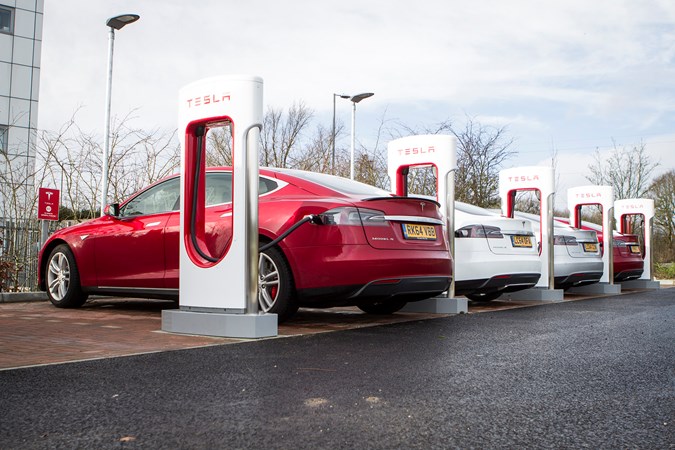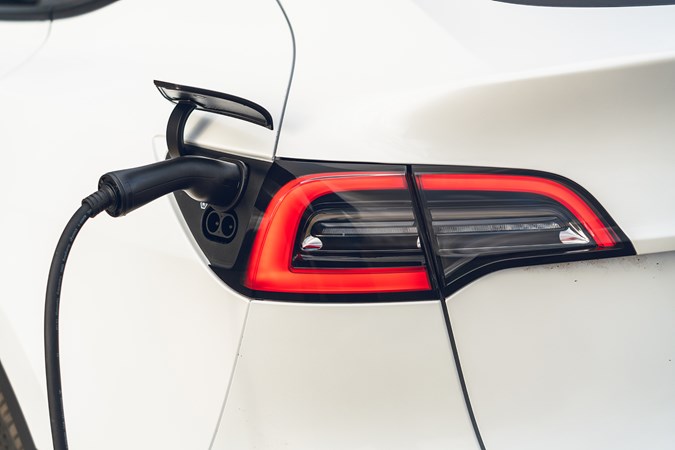Of the 35,000 Tesla Superchargers available globally, 1,000 of them can be found in the UK. Of those, 158 of those in 15 locations are available to electric vehicle (EV) drivers beyond Tesla drivers.
In May 2022, Tesla announced that it would be expanding its pilot scheme to allow non-Tesla drivers to top up their range via the Supercharger network at various locations across the UK.
Prior to this, only Tesla drivers have been able to use the network. To counter any loss of access or availability to Tesla drivers, the locations of the pilot have been carefully selected as sites which have ‘available capacity’. Jump down to see the following information:
15 locations where non-Tesla drivers are welcome at Tesla superchargers as part of the trial are:
- Aberystwyth (SY23 3TL)
- Adderstone (NE70 7JU)
- Aviemore (PH22 1PN)
- Banbury (OX16 1LX)
- Birmingham-St Andrews (B10 0BW)
- Cardiff (CF23 8HE)
- Dundee (DD2 5JT)
- Flint (CH6 5QG)
- Folkestone Eurotunnel (CT18 8XX)
- Grays (DA9 9ST)
- Manchester Trafford Centre (M41 7FZ)
- Trumpington (CB2 9FT)
- Thetford (IP24 3TP)
- Uxbridge (UB8 1QJ)
- Wokingham (RG41 5DD)
‘We will eventually welcome both Tesla and non-Tesla drivers at every Supercharger worldwide,’ Tesla said, indicating clear plans to expand the initiative.
The latest news
In recent months, several manufacturers including Nissan, Ford, Volvo and Mercedes-Benz have agreed to equip their future models with Tesla’s North American Charging Standard (NACS) socket.
As more cars roll off the production line equipped with NACS, the industry charging standard is shifting away from the Combine Charging System plug toward a new landscape on which the Tesla charger plays centre stage.
More importantly, however, it signifies a relaxation of Tesla’s attitude towards other manufacturers using its superior Supercharging network – a move that could negate some of the current limitations of electric driving. Fast, stress-free charging for all (with NACS).
How do non-Tesla drivers charge up at a Supercharger?
It’s worth noting that none of the supercharger networks have screens or contactless payment devices. The only way to interact with them is with the Tesla app. But don’t fear, each Tesla supercharger location has guest wifi, with the password available at the location.
While Tesla drivers will continue to pay £0.28 per kilowatt-hour (kWh). Non-Tesla drivers should expect to pay around quite a bit more, around £0.69 per kWh.
If you’re going to be regular user of Tesla Superchargers, you can get a charging membership. It costs £10.99 per month and reduces the price per kWh you’ll pay. Full details of how to charge are here.

How fast does a Tesla Supercharger charge?
Fast. Tesla Superchargers use direct current (DC) to deliver power to your EV. They tend to range from 54kW to 150kW charging. For comparison, home chargers are usually 3kW or 7kW and some slower destination chargers can be 22kW.
These higher numbers mean two things: a) Tesla chargers can replenish a decent chunk of mileage very quickly and b) they won’t be suitable for use with every electric vehicle. This is because the power delivery of the chargepoint isn’t the only thing that determines how quickly an EV can charge.
To find out more about the effect of temperature on battery chargers, be sure to check out our article on how long it takes to charge a vehicle battery. It’s also worth mentioning that pre-conditioning the battery has an effect on charging times too. In 2019, an over-the-air (OTA) update called On-Route Battery Warmup enabled Tesla drivers to get better performance from their charging periods.
The on-board computer knows when a Tesla driver is en-route to a Tesla Supercharger charge point. The car then begins to prepare the battery for charging. Essentially this means warming the battery cells up (hence the name!) so power delivery is as effective as possible. This helps shorten charging times, or maximise mileage during your driving break—whichever way you wish to look at it.
What is Tesla V3?
It’s likely you’ve noticed the fields of distinctly designed Tesla Superchargers with their red and white housing at motorway service stations dotted around the UK in various places. Most of these Superchargers deliver between 54kW and 150kW, depending on local availability of electricity source.
Tesla’s latest V3 superchargers can deliver up to 250kW peak charging. This is achieved by adding an exclusive power supply to a charge point. By not sharing the flow of energy with any other charge points, the V3 technology enables a Tesla Model 3 Long Range a charge of 75 miles in only five minutes—in theory, at least.
In the UK, there’s only one V3 Tesla Supercharger at Park Royal Tesla Service Center near London (W3 0SL). You’ll know if you’re using a V3 charger, since the cable is thicker. This is because it’s air-cooled, not liquid-cooled.

How to plan a trip with Tesla Superchargers
Tesla drivers can also access a helpful journey planner, which maps out any route with a Tesla. It’s able to carefully calculate a route, favouring the Supercharger network, though we’d advise caution.
In a journey needing to get from Oxford to Worcester, the navigation wanted to guide us up the M40 via Stratford-upon-Avon’s Supercharger, when the cross-country route was a shorter distance with plenty of opportunity for regenerative braking. We arrived at our destination charger with miles to spare and at least 30 minutes earlier than if we’d followed Tesla’s guidance.



